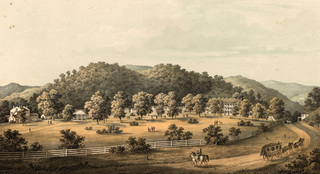 | Back to e-WV
| Back to e-WV
 The West Virginia Encyclopedia
The West Virginia Encyclopedia
 | Back to e-WV
| Back to e-WV
 The West Virginia Encyclopedia
The West Virginia Encyclopedia

Blue Sulphur Springs, located in Greenbrier County near Smoot, was the site of a mineral spring resort from 1834 until 1858, one of many in the Western Virginia mountains. The sulfur spring, which gives the site its name, was developed into a resort in 1834 when owner George Washington Buster built a three-story brick hotel with 200 rooms, as well as a springhouse, cottages, and bathing facilities. The first mud baths in the United States were introduced there in the 1840s.
Famous visitors to Blue Sulphur Springs included Andrew Jackson, Martin Van Buren, Henry Clay, and Robert E. Lee. In 1858, the resort property was sold to the Western Virginia Baptist Association, which established Allegheny College there in 1860. During the Civil War the property was occupied by both armies. In 1863, a Confederate regiment wintering there lost almost 100 men to exposure and disease; they were buried on a hillside overlooking the resort, many in coffins made from the resort’s furniture. In 1864, Union troops burned down the resort buildings.
Today, only the pavilion that was built over the spring is still standing. In 2013, Preservation Alliance of West Virginia listed the pavilion as an endangered property. Local historical groups obtained grants and private funding to save it. Restoration work began in 2020 with added drainage and steel reinforcements. The completely restored pavilion was dedicated on July 2, 2023. It is the only resort pavilion remaining in the state and one of the few Greek Revival style structures in rural West Virginia.
Written by Michael M. Meador
Cohen, Stan. Historic Springs of the Virginias. Charleston: Pictorial Histories Publishing Company, 1981.
Skeldon, Katherine. Groups Celebrate Revitalization of Blue Sulphur Springs Pavilion. WV Metro News, July 2, 2023.